From herbs to moss and more, we share a first instalment from our friends at Ethical.net about sustainable alternatives to garden lawns.
Most gardens will have at least some lawn. This is not necessarily a bad thing, but few of us stop to consider whether there might be better alternatives. A lawn can be practical, but there are many more arguments for replacing it with something preferable.
If you feel like a change but aren’t quite sure what to do with your outside space, read on to discover some amazing eco alternatives to a garden lawn.
Why get rid of your lawn?
A typical lawn is more or less a mono-culture. It usually has just one main plant – grass – and many gardeners struggle to get rid of any ‘weeds’. But this is not natural; diversity is key to a healthy ecosystem, and fighting to maintain a grass mono-culture harms the garden ecosystem. This is not only detrimental to local wildlife, but can also be bad for us in the long term, as the environment suffers.
And, let’s face it, the lack of diversity in a lawn can be downright boring. By choosing different plants and creating a range of habitats, we can enhance our neighbourhoods, making them livelier and more interesting places.
Losing that lawn can make things easier for gardeners, too. Lawns can be a chore to mow, and what’s more, they can often become boggy and waterlogged in winter, or parched during the summer.
They often straddle areas with very different conditions – partly in full sun and partly in deep shade, for example, leading to lawns that look patchy and sometimes downright ugly. If you have a problematic lawn, why not give up the fight and consider something that works better for you, and for where you live?
What to consider when choosing an eco lawn-alternative
Before discussing alternatives, it’s worth considering the following:
Choose the right plants for the right places
If you are planning to replace your lawn with other plants, one of the most important considerations is whether those plants are suited to your garden. In an eco-friendly, sustainable garden, you will usually want as many different plants as possible – but the right plants must be chosen for the right places. Bear in mind:
- How much sunlight there is in the location you are choosing a plant for, and when the area is sunny and when it is in shade. Consider this not only in relation to each day, but also throughout the year.
- Whether the location is sheltered or exposed.
- How water travels through that spot – is it waterlogged, or very dry at certain times?
- The type, pH, quality, and fertility of the soil.
- Other plants growing nearby, and how these might aid or hinder new plants.
Make the most of your space for your own needs
It is very important to think about how your garden might better meet your own personal needs. An eco-friendly and ethical life involves taking control of your needs, and working out how to meet them without harming either other people or the planet.
A garden can meet many of our needs, helping us withdraw support for damaging systems. When weighing up alternatives to a traditional grass lawn, consider whether what you replace it with could:
- Provide food for you and your family.
- Provide other yields, such as fuel for heating, timber, and natural materials for crafting and DIY projects, herbal medicines, etc.
- Meet you and your family’s recreational needs. (Helping you stay happy and healthy in mind as well as in body.)

Photo by Douglas Bagg on Unsplash.
Improve the amenity of the garden for human inhabitants
As well as considering how an eco-alternative could meet your needs, examine whether or not it might improve the relationship of your garden to the surrounding environment. A lawn-alternative might improve the amenity of your garden for human inhabitants by:
- Increasing privacy.
- Decreasing the impact of pollution/smells from nearby roads.
- Reducing noise pollution from roads or nearby properties.
Enhance your garden for local wildlife
Ethical gardeners will not only give thought to human inhabitants’ needs and wishes, but also those of local wildlife. You and your family are not the only creatures who use your garden; consider whether the alternative you choose will impact wildlife positively.
Work within your own time constraints and abilities
All of the above will help you to make a sensible, eco-friendly, ethical choice for you and your garden. But whatever you are considering, you have to be practical: take your own time constraints and abilities into account. Only by doing so will you create a truly sustainable garden.
So, now you have considered the basics, let’s look at some of the options:
Creating a neat lawn without grass
First of all, a lawn does not have to be grass. If you decide that you like the openness of your garden, and wish to stick with low-level ground cover, consider creating a lawn with other plants – ones that might be better suited to local conditions, and which will not require mowing. For example:
Herbs
Mediterranean herbs such as thyme, oregano, and marjoram can create pleasant lawns in areas of high sunlight and low rainfall. Camomile is also often used to create lawn areas; some mints, too, spread quickly, creating excellent ground cover. Fragrant herbs will smell divine and can be practical as well as attractive, providing a small edible yield, being useful for herbal medicine, and attracting wildlife.

Photo by Roksolana Zasiadko on Unsplash.
Clovers
Clovers are often considered to spoil the neat appearance of a grass lawn, but planting clover as an alternative open area could be a good move; by working with bacteria, they fix nitrogen from the air, which is excellent for the soil and surrounding plants.
Moss
Moss is ideal for areas that are shaded and boggy, perhaps beneath trees or in deep shade. Though not usually desired when it creates patches in a grass lawn, it could be an attractive solution for ground cover in areas where grasses will not usually thrive.
Turning a lawn into a low-maintenance wildlife haven
All of the suggestions above will increase the biodiversity in your garden to some degree. But the following could turn your garden into a true low-maintenance wildlife haven:
Letting your lawn go wild
Improve your garden as a habitat for wildlife by joining the ‘no-mow’ movement, allowing nature to take its course. In an organic garden, simply let ‘weeds’ and other plants colonise your lawn, so it becomes a lush polyculture. A natural lawn will, of course, include grasses – but these will be able to flower and seed. It might also include:
- Nitrogen fixers like clover.
- Weeds or lawn flowers such as dandelions, daisies, creeping primrose, germander speedwell, selfheal (Prunella vulgaris), and chickweed.
- Larger plants that self-seed, such as thistles, nettles, dock, cow parsley, and broadleaf plantain.
Of course, the species you see popping up in your lawn will largely depend on the soil type and conditions where you live. But forgoing mowing can have a hugely positive impact on local wildlife almost immediately.
If it is a little difficult to cross your newly wild lawn, consider mowing pathways through it to allow access to other parts of your garden.
Replacing your lawn with a wildflower meadow
To go further and attract even more wildlife, sow wildflower seeds to create your very own meadow. Meadow habitats are becoming scarce in the UK, so planting native meadow plants could help preserve this precious ecosystem. What’s more, a wildflower meadow can look wonderful too.
The key is to not plant generic wildflowers, but rather a wildflower mix suitable for, and native to the region where you live. This will not only ensure that they do well, but also that they are suitable for local insects and other wildlife.

Photo by Mike Erskine on Unsplash.
Creating other wildlife habitats where your lawn used to be
A meadow is not the only habitat that could replace your lawn. Just some other wildlife-friendly habitats could include:
- A wildlife pond.
- One or more blossoming trees or shrubs. (You may be surprised to learn that just five flowering fruit trees can provide the same amount of pollen and nectar for pollinators as an acre of meadow!)
- A stumpery or rockery, with plenty of hidey-holes for bugs and beetles, and perhaps warm surfaces for reptiles to bask on.
- A butterfly haven, with plants to encourage these beautiful creatures into your garden. Buddleia – the butterfly bush – could be a good starting point for a new planting scheme.
- A herb spiral or other herb garden to attract a range of beneficial creatures.
Stay tuned for Part 2 coming soon, exploring easy edibles, perfect playgrounds and permeable patio areas.
Find the original post by Elizabeth Waddington here on the Ethical.net blog. Main image by Petar Tonchev on Unsplash.
 About the author
About the author
Ethical.net is a collaborative platform for discovering and sharing ethical alternatives, whether purchasing from a social enterprise, thrift shopping, or learning how to fix your old phone instead of buying a new one. They aim to make ethical the new normal.

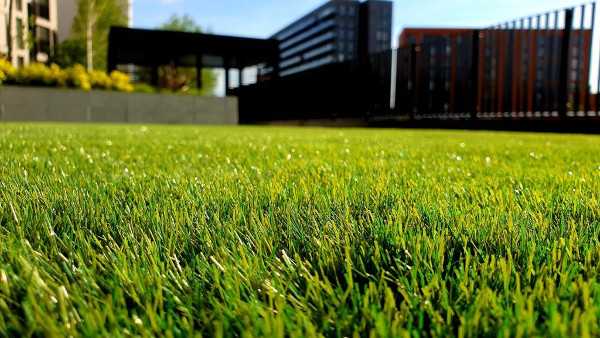

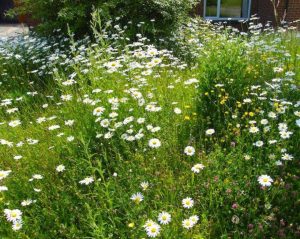
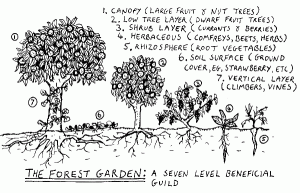
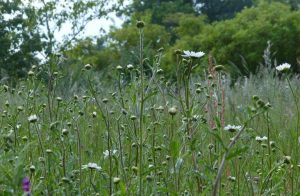
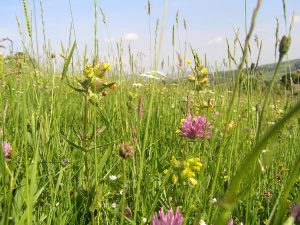
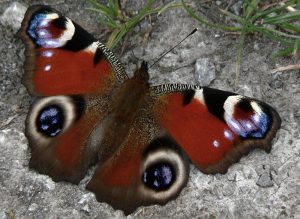
2 Comments
Plenty of people round here have such huge mown areas that they have to have ride-on mowers; and then complain when the mowers get stolen. They could have reared a couple of pretty little sheep, or some poultry, and had all the benefit of them.
Whilst that looks on the face of it a great idea we then come into a whole mix of – what do we do with those “pretty sheep” or the poultry? Do we “crop them” (by this I mean do we use the sheep and/or the poultry as a crop?). Do the local byelaws allow you have such pets in your garden, do we eat them or just use their wool/eggs etc. Will the “nice neighbours” complain about the noise and or smells coming from those animals, Do we lose our family communal space? What about the children? Can they catch things from those self same animals? It goes on and on – yes Hilary to me I think it is a very good idea but, there are many so called complications to consider before putting the first shovel full of dirt onto the new “patch”. I’d be very interested in your views on this as well as the views of Ethical.net on the whole set up – bottom line is it going to be worthwhile doing this? or will it be better to just leave it all alone and think again?
I think possibly the main problem in this day and age is the change that will occur to the property and surrounding areas especially from a legal point of view – the dreaded Planners!